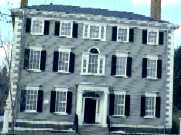Click to Enlarge
 fig.
1 Maison Carree, Nimes, France
fig.
1 Maison Carree, Nimes, France fig.2,
Capitol Bldg, ca. 1790, Richmond, Virginia
fig.2,
Capitol Bldg, ca. 1790, Richmond, VirginiaThe Federal Style takes its name from the era in American history which shares this name. This historical period (1783-1815) was of extreme importance for the establishment of the United States; it saw the end of the revolution, the creation of Articles of Confederation, and finally the Constitution of the United States and the Bill of Rights. It was personified in the great men of the time, founding fathers such as George Washington, John Adams, Thomas Jefferson, James Madison and Alexander Hamilton, all of whom transformed their ideological beliefs into a blueprint for a nation. In the wake of the fervor surrounding the formation and shape of the new country, the founding fathers sought to create a national identity to bind the new republic and its citizens together. For this, they looked to the same source that had given them so much inspiration during the quest for independence--the great ancient society, Rome. Seeking to endow the nation with the attributes that had made Rome the great society of antiquity, the federal fathers looked to the ancient city as a model for their own nation's government, education, and arts.
In 1785, Thomas
Jefferson, in extoling the beauty of the Maison Carree (fig. 1), the first
century BC temple in southern France which served as the inspiration for
his new Virginia Capitol building in Richmond (fig. 2), said: "We took
for our model what is called the Maison Quarree of Nismes, one of the most
beautiful, if not the most beautiful and precious morsel of architecture
left us by antiquity. It was built by Caius and Lucius Caesar, and repaired
by Louis XV, and has the suffrage of all the judges of architecture who
have seen it as yielding to no one of the beautiful monuments of Greece,
Rome, Palmyra and Balbec, which late travelers have communicated to us.
It is very noble beyond expression, and would have done honor to any country,
as presenting to travelers a specimen of taste in our infancy, promising
much for our maturer age."
| Slide
Gallery:
Click to Enlarge |
 fig.
1 Maison Carree, Nimes, France fig.
1 Maison Carree, Nimes, France |
 fig.2,
Capitol Bldg, ca. 1790, Richmond, Virginia fig.2,
Capitol Bldg, ca. 1790, Richmond, Virginia |
The American Federal Style is
directly related to the mid-eighteenth century architecture of England
and the Adam Brothers,
who in turn were directly influenced by the
architecture of Rome and by archaeological findings which concluded that
Roman domestic architecture, especially its interiors, had not been as
standardized as many architects had previously believed. Thus, these styles
of architecture, both the Adamesque and the American Federal, reflected
this realization and were characterized chiefly by an intricate, unique,
and singular use of interior space, within a simple, symmetrical, geometrically
based Roman cube on the exterior. In Britain, the Adam brothers ushered
in a new architectural style, catering to the elite, with their revisionist
neo-classical architecture. In the United States, especially in the maritime
towns of the Atlantic seaboard, with its close trading ties to England,
the Federal Style found its greatest popularity with these wealthy, sea-trading
merchants. The American Federal style retained the English interior grace
and opulence (see Fig. 3), as well as its singularly unique use of space.
However, the exterior became severely plain, employing little, if any,
ornamentation (see Fig. 4). This austerity greatly appealed to the Puritan
values of New England, where an ostentatious outward appearance would have
been frowned upon. There, in the hotbed of political support for the Federalist
Party, the Federal Style gained prominance as an architectural expression
of the power, wealth, and influence of its members
 Fig.
3 Intricate Ceiling Designs of Adamesque Home - 18th&19th Century Fig.
3 Intricate Ceiling Designs of Adamesque Home - 18th&19th Century |
 Fig.
4 Modest, balanced exteriors of 19th Century Federal Style Home; Salem,
MA Fig.
4 Modest, balanced exteriors of 19th Century Federal Style Home; Salem,
MA |
This new style was ushered in by new heralds, architects who practiced their art not as a trade but as a profession. These heralds, the new breed of American architects, were men such as Samuel McIntyre, William Thorton, and Charles Bulfinch. Their work, in both the domestic and civic spheres of architecture gave the young American nation its identity.